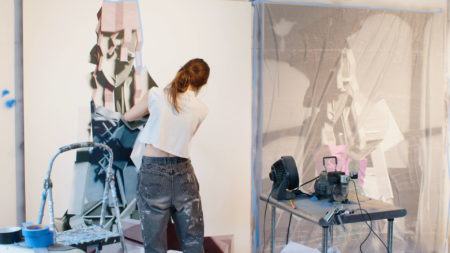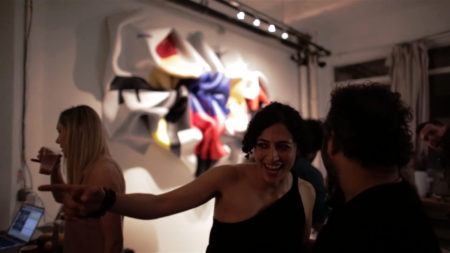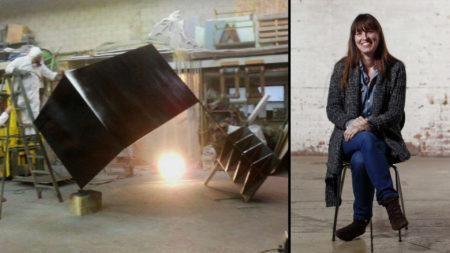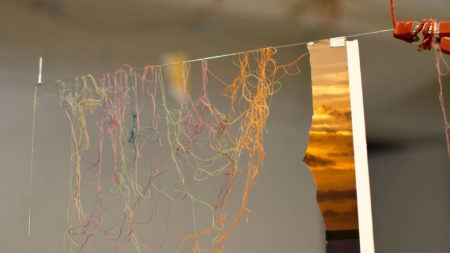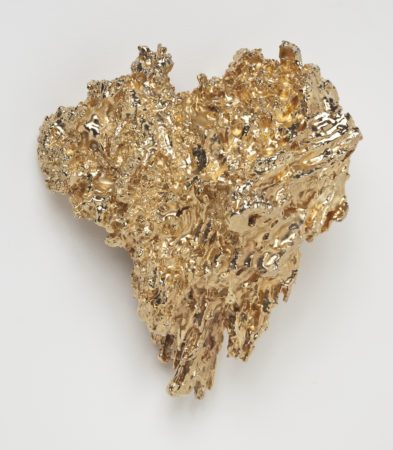Continue playing
(Time remaining: )
Play from beginning
Continue playing "{{ controller.videos[controller.getVideo(controller.currentVideo)].segmentParentTitle}}"
{{controller.videos[controller.getVideo(controller.currentVideo)].title}} has ended.
Distorting Form with ColorLiz Larner
Strolling through the Los Angeles County Museum of Art, Liz Larner discusses her interest in separating color from form in her sculptural work. Using Minimalist sculptor Tony Smith’s large-scale geometric piece Smoke (1967) as a starting point, Larner shares her personal love for the sculpture, currently installed in the atrium of the museum’s Ahmanson Building. “Just to see what sculpture can do,” says the artist, “this I think is probably one of the greatest examples of that ever.”
Smith’s work functions as both an investigation of abstracted geometric forms and an activation of the spatial voids surrounding the piece. Larner sees her own work as a continuation of this idea, with one notable difference: color.
“Color, it’s such a huge part of our perception,” says the artist, “so to be able to use it as a material and make it work volumetrically…is something that’s very interesting to me.” Larner’s approach is especially evident in her 2010 sculpture 6, filmed while on view at the Art Institute of Chicago in 2015. “There doesn’t have to be an equivalency between volume, mass, and density.”
Credits
Producer: Véronique Bernard & Ian Forster. Interview: Véronique Bernard & Deborah Dickson. Editor: Morgan Riles. Camera: Scott Anger & Steve Delahoyde. Sound: Theresa Radka. Artwork Courtesy: Liz Larner, Regen Projects, & © Tony Smith Estate / Artists Rights Society (ARS), New York. Music: Roger Plexico & The Underscore Orkestra. Special Thanks: The Art Institute of Chicago & The Los Angeles County Museum of Art.
Extended Play is supported, in part, by the New York City Department of Cultural Affairs in partnership with the City Council; Art21 Contemporary Council, and by individual contributors.
Closed captionsAvailable in English, German, Romanian, Italian, Japanese, Korean, Chinese, Italian
Through the Art21 Translation Project, multilingual audiences from around the globe can contribute translations, making Art21 films more accessible worldwide. Translate this video now.
Interested in showing this film in an exhibition or public screening? To license this video please visit Licensing & Reproduction.
Liz Larner experiments with abstract sculptural forms in a dizzying array of materials, including polychromatic ceramics that evoke the tectonic geologic shifts of the western landscape. An inventor of new forms, Larner’s sculptures are not easy to categorize. They defy easy description by design, such as the geometric sculpture of a cube turning into a sphere that is both yet neither, or a complex chain of linked metal rings that never tangles and can also be worn as jewelry. Working with both analog and digital tools, Larner’s materials change from work to work and can include fiberglass, crystals, paper, clay, aluminum, steel, rubber, epoxy, mirror, cloth, and even bacteria. As daring as her investigation into new forms can be, Larner’s sculptures are approachable in their human scale and idiosyncratic vision that favors personal narrative over minimal austerity.
“We’re not really used to seeing colors distort form by not following it.”
Liz Larner
History Reimagined
Being Boring
Art historian Ben Street reflects on the contemporary evolution of sculpture, beginning with Charles Baudelaire’s 1848 question, “Why is sculpture so boring?”
Do Ho Suh
Sarah Sze
Arlene Shechet


